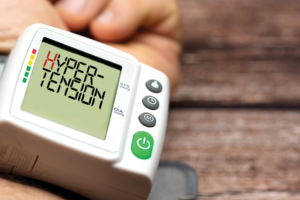
Hi, I am Kathleen Meyer, a Registered Dietitian and Sales Manager at Patient Care America. For over 29 years I have worked with patients, many of whom receive dialysis. Unfortunately, in December 2020, I became a patient myself. After suffering a hemorrhagic stroke, I was diagnosed with hypertension. Before my diagnosis, I had no warning signs or symptoms. Now, I understand more than ever why it is called the “silent disease.”
Hypertension affects almost half of U.S. adults and increases the risk of heart disease, stroke, and kidney disease. Managing blood pressure is more than just taking medication, it is about making changes to your daily routine that can have a significant impact. While some risk factors like age and family history are beyond your control, many lifestyle changes can reduce your risk of developing hypertension:
Watch Your Salt Intake: Did you know the average American consumes 3-4 grams of sodium daily? That is much higher than the recommended 2.3 grams for someone with chronic kidney disease (CKD). Follow a heart-healthy diet, rich in fruits, vegetables, whole grains, lean proteins, and healthy fats.
Avoid excess sugar and processed foods, which can contribute to weight gain and higher blood pressure.
Stay Active: Aim for at least 30 minutes of moderate exercise most days of the week. Activities like walking, cycling, or yoga can strengthen your heart
and help regulate blood pressure.
Manage Stress: Life can get hectic, but taking a moment to breathe deeply or meditate can really help lower your blood pressure. I have even found guided meditations that are free on YouTube—they are simple and calming.
Healthy Sleep Habits: Stick to a consistent sleep schedule, aiming for 7-8 hours of quality sleep each night. Poor sleep can increase your risk of hypertension.
Recognizing the Silent Disease
Hypertension is often called the “silent disease” because many people have no symptoms until complications arise. However, some individuals
may experience:
- Headaches
- Dizziness
- Blurred vision
- Shortness of breath
Regular blood pressure checks are the best way to catch hypertension early, as symptoms may not appear until considerable damage has occurred.
After my stroke, I had to make some additional changes. I was already eating a heart-healthy diet, but I had to become even more intentional about other aspects of my life. In addition to taking the prescribed medication, I also purchased a BP monitor and started tracking my blood pressure. Seeing the patterns helped me stay on top of things and gave my healthcare team useful info. In addition to these important new steps I implemented in my daily routine,
I also began to implement relaxation techniques daily that have helped me reduce stress. Whether it is deep breathing, mindfulness, or just spending quiet time with my family, I have learned how to slow down and take care of my mental health as well.
By taking steps to prevent hypertension or manage it effectively, you can significantly lower the risk of life-altering complications like heart disease
and stroke. If you or someone you care for is dealing with high blood pressure, remember that small, consistent efforts can make a substantial difference.
For additional resources, including patient handouts on blood pressure management, visit our clinician portal or contact your healthcare provider.
Together, we can take charge of hypertension and improve overall health and quality of life.
We thank our guest blogger, Kathleen Meyer, RD, LD Sales Manager for sharing her knowledge and writing this blog post!

